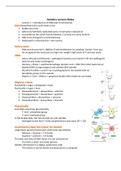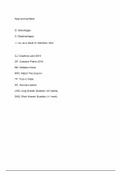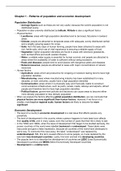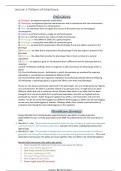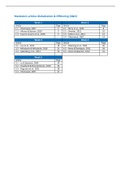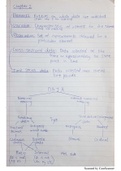SUMMARY ENVIRONMENT & ENGINEERING
,INTRODUCTION TO THE COURSE (LECTURE 1)
Ø Daly’s: Disability Adjusted Life Year
o = A measure of overall disease burden, expressed as the cumulative number
of years lost due to ill-health, disability or early death
o = YLD (Years Lived with Disability) + YLL (Years of Life Lost)
§ YLD = I (number of incident cases) x DW (disability weight) x L
(average duration of the case until remission or death)
§ YLL = N (number of deaths) x L (standard life expectancy age of death
in years)
Ø Relation Spatial Planning & Daly’s
o Rationale: 4% invloed via environment (grotendeels door Spatial Planning)
o P2 syllabus: reasons why Daly’s are higher than necessary in NL (marked =
important for this course)
Ø General
o Phenomena in this course are complex, multi-scalar and focus on both long &
short-term
Ø #Makingplacesbettertogether
o We have an impact on the environment & we can change it for the better! With
Spatial (Environmental) Planning!!
o Policies: simple problem, simple policies; complex problem, complex policies
o We should make sure that we get a positive frame! To do so:
§ Seek: to empower future placemakers to make places better
§ Help: to make sense of complexity, contextuality and community by
using a socio-spatial approach
§ Develop: theoretical and practical skills
§ Believe: That the global and local enhancement of well-being is best
achieved by innovation and spatial transformation that is socially
acceptable and sustainable.
Ø Course outline
o 5 themes
§ Atmosphere
§ Air pollution
§ Radiation
§ External Safety
§ Applied Thermodynamics
, THEME 1: ATMOSPHERE
The student can explain in own words how the atmosphere is working and explain how wind
flows function, in order to connect that knowledge to the distribution of noise, radiation and
pollution through the physical environment.
DISTRIBUTION OF POLLUTION IN GENERAL
Ø Compartments of physical environment (through which matter, sound and
radiation can distribute in various ways)
o Deep surface (lithosphere)
o Soil including plants and animals (biosphere) (through particles)
§ Precipitation in an unsaturated soil layer
§ Flows of groundwater
§ Diffusion
o Water (hydrosphere) (through diffusion)
§ Advection / Convection (movement of water)
§ Diffusion (movement of molecules from high to low concentration)
o Air (atmosphere) (most of all of them: through wind)
§ Much more mobile compared to soil & water!
Ø Speed of distribution depends on
o Matter specific physical constant of diffusion (every substance has a speed)
o Temperature (higher temperature, higher speed)
o Pressure differences (“the bigger the faster”)
Ø Distribution of matter / sound / radiation via wind (= atmospheric movement)
o Matter à mainly distributed via atmospheric movement: wind
o Sound (waves, energy) à much less
o Radiation à almost zero
COMPOSITION OF THE ATMOSPHERE (quantity & quality)
Ø Composition (mixing ratio) è quantity
o Most gases have a long residence time in the atmosphere à constant mixing
ratio consisting of mainly…… (zie p.4 syllabus)
§ N2 (Nitrogen) = 78%
§ O2 (Oxygen) = 21%
§ Others (CO2, O3 etc) = 1%
• This ‘almost nothing’ has an important impact on our
environment! That we as spatial planners can influence!
(Qquality!)
o Exceptional position of water vapour
§ Variable mix ratio of almost 0-4% (Depending on temperature)
§ è so composition of the atmosphere can be more than 100%
Ø Concentration (& Diffusion) è quality
o Concentration is a driving force for diffusion.
§ Higher concentration à more rapid mass transport in air and water
o Mass Fraction
§ = Concentration of contaminants (particular substance) in air and solid
material (particular compartment) (per gram)
o Expressed in ppm (parts per million)
§ = Mass Fraction (gram) x 106
§ Useful because you can now interpret the numbers
,INTRODUCTION TO THE COURSE (LECTURE 1)
Ø Daly’s: Disability Adjusted Life Year
o = A measure of overall disease burden, expressed as the cumulative number
of years lost due to ill-health, disability or early death
o = YLD (Years Lived with Disability) + YLL (Years of Life Lost)
§ YLD = I (number of incident cases) x DW (disability weight) x L
(average duration of the case until remission or death)
§ YLL = N (number of deaths) x L (standard life expectancy age of death
in years)
Ø Relation Spatial Planning & Daly’s
o Rationale: 4% invloed via environment (grotendeels door Spatial Planning)
o P2 syllabus: reasons why Daly’s are higher than necessary in NL (marked =
important for this course)
Ø General
o Phenomena in this course are complex, multi-scalar and focus on both long &
short-term
Ø #Makingplacesbettertogether
o We have an impact on the environment & we can change it for the better! With
Spatial (Environmental) Planning!!
o Policies: simple problem, simple policies; complex problem, complex policies
o We should make sure that we get a positive frame! To do so:
§ Seek: to empower future placemakers to make places better
§ Help: to make sense of complexity, contextuality and community by
using a socio-spatial approach
§ Develop: theoretical and practical skills
§ Believe: That the global and local enhancement of well-being is best
achieved by innovation and spatial transformation that is socially
acceptable and sustainable.
Ø Course outline
o 5 themes
§ Atmosphere
§ Air pollution
§ Radiation
§ External Safety
§ Applied Thermodynamics
, THEME 1: ATMOSPHERE
The student can explain in own words how the atmosphere is working and explain how wind
flows function, in order to connect that knowledge to the distribution of noise, radiation and
pollution through the physical environment.
DISTRIBUTION OF POLLUTION IN GENERAL
Ø Compartments of physical environment (through which matter, sound and
radiation can distribute in various ways)
o Deep surface (lithosphere)
o Soil including plants and animals (biosphere) (through particles)
§ Precipitation in an unsaturated soil layer
§ Flows of groundwater
§ Diffusion
o Water (hydrosphere) (through diffusion)
§ Advection / Convection (movement of water)
§ Diffusion (movement of molecules from high to low concentration)
o Air (atmosphere) (most of all of them: through wind)
§ Much more mobile compared to soil & water!
Ø Speed of distribution depends on
o Matter specific physical constant of diffusion (every substance has a speed)
o Temperature (higher temperature, higher speed)
o Pressure differences (“the bigger the faster”)
Ø Distribution of matter / sound / radiation via wind (= atmospheric movement)
o Matter à mainly distributed via atmospheric movement: wind
o Sound (waves, energy) à much less
o Radiation à almost zero
COMPOSITION OF THE ATMOSPHERE (quantity & quality)
Ø Composition (mixing ratio) è quantity
o Most gases have a long residence time in the atmosphere à constant mixing
ratio consisting of mainly…… (zie p.4 syllabus)
§ N2 (Nitrogen) = 78%
§ O2 (Oxygen) = 21%
§ Others (CO2, O3 etc) = 1%
• This ‘almost nothing’ has an important impact on our
environment! That we as spatial planners can influence!
(Qquality!)
o Exceptional position of water vapour
§ Variable mix ratio of almost 0-4% (Depending on temperature)
§ è so composition of the atmosphere can be more than 100%
Ø Concentration (& Diffusion) è quality
o Concentration is a driving force for diffusion.
§ Higher concentration à more rapid mass transport in air and water
o Mass Fraction
§ = Concentration of contaminants (particular substance) in air and solid
material (particular compartment) (per gram)
o Expressed in ppm (parts per million)
§ = Mass Fraction (gram) x 106
§ Useful because you can now interpret the numbers


